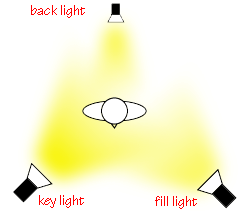Photography Skills
14/11/2015
Rule of Thirds

Though it is not an official photgraphy rule used in every photograph, the rule of thirds is used in professional photography in order to angle the chosen picture within the nine squares. The four highlighted cross sections often focus on the main aspects of the photo. It is also applied by aligning a subject with the guide line and their intersection point, placing the horizon on the top or bottom line, or allowing linear features in the image to flow from section to section.
When we begin to photograph the photos for our digipak and magazine advert, we will have to consider the grid that is present within the rule of thirds. As we plan to be standing against the rule, we must be evenly spread in order to create equality in the photo so that it doesn't look odd to the viewer. We will also try to keep at an equal height between us all in order to create an even horizon.
3-point Lighting System

Three-point lighting is a standard method used in visual media such as theatre, video, film, still photography and computer-generated imagery. By using these three different shots, the photographer can illuminate the subject however they wish. The three different lighting systems are:
Key Light
The key light acts as the main light and illuminates the subject directly upon their face. It is often the most strong light also. Indoor shot lights can be lamps or simply camera flashes, while outdoors the light can be as natural as the sun.
Fill Light
The fill light also shines upon the subject, but from the side and from a lower angle. It balances the key by illuminating shaded surfaces. It is used to cast shadows on the face and create mystery within many films.
Back Light
The back light shines upon the subject from behind on their hair or shoulders. It is used to highlight contours as well as brighten the rim of the subject in order to seperate them from the background.
When it comes to our photoshoot for our magazine advert and digipak, we will have to consider all three angles. We plan to have a white background with no shadows, so we will need to create equal amounts of light from each angle.

